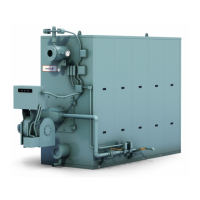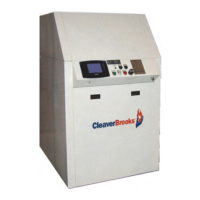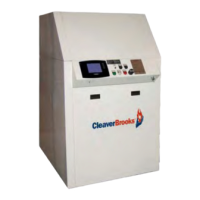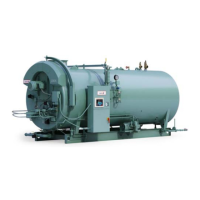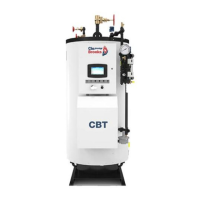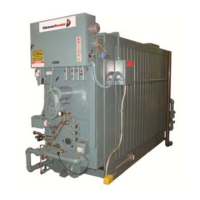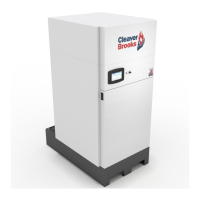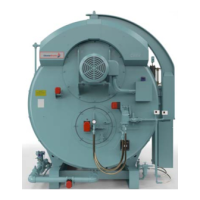Chapter 2 Profire V Burner
2-24 750-177
11. Do not repeat unsuccessful light off attempts without rechecking burner and pilot adjustment. Vent fuelvapors from the combus-
tion chamber after each unsuccessful light off attempt.
12. Set the gas low fire rate by adjusting the butterfly valve and air linkage.
13. When low fire is adjusted, shut down the burner.
14. Restart several times to be sure the low fire setting is suitable. Readjust if necessary. Never start theburner with fuel vapor in the
furnace. In case of an emergency, open the main power switches and closeall fuel valves.
15. After combustion adjustments are satisfactorily set, allow the heating vessel to slowly reach normaloperating pressure or tem-
perature.
16. Turn the potentiometer switch to the high fire position. Check high fire at this point using combustioninstruments.
17. Do not disturb established low fire adjustment. Allow the burner to return to low fire position before adjusting high or intermedi-
ate settings.
Do not repeat unsuccessful light off attempts without rechecking burner and pilot adjustment. Vent fuel vapors
from the combustion chamber after each unsuccessful light off attempt. Set the gas low fire rate by adjusting
the butterfly valve and air linkage. Refer to the adjustment section of this manual. Using the combustion
analysis instrument, adjust the low fire. Typical combustion analysis for low fire is 5% to 6% O2 on standard
turndown systems, and between 6.5% and 9% for higher turndown systems. Verify the minimum input rate
by measuring the gas meter.
When low fire is adjusted, shut down the burner. Restart several times to be sure the low fire setting is suitable.
Readjust if necessary. Never start the burner with fuel vapor in the furnace. In case of emergency, open the
main power switches and close all fuel valves. After combustion adjustments are satisfactorily set, allow the
heating vessel to slowly reach normal operating pressure or temperature.
After the boiler has reached operating temperature or pressure, turn the potentiometer switch in small
increments to the high fire position. Check high fire at this point using combustion instruments. High fire
combustion analysis typically is 3% to 4% O2. Verify maximum input rate by measuring the gas meter.
Do not disturb established low fire adjustment. Allow the burner to return to low fire position before adjusting
high or intermediate setting. CO levels should be less than 400 ppm on an air-free basis at all firing rates,
with <50 ppm as the target value.
When conditions covered above are assured, refer to NORMAL OPERATION below.
Oil Burners
1. The fuel selector switch should be set to “OIL” and the “ON-OFF” switch is in the “OFF” position.Actuate the manual reset but-
ton of the flame safeguard control to close the safety switch contacts.Set the ON-OFF switch to ON. The burner will start and
pre-purge. After pre-purge, the ignition transformer will direct spark. If the flame detector proves the presence of a satisfactory
pilot, the programmer will proceed to main flame ignition.
2. Set the “ON-OFF” switch to “ON.” The burner will start and pre-purge. After pre-purge, the ignition transformer will direct spark.
If the flame detector proves the presence of a satisfactory pilot, the programmer will proceed to main flame ignition.
3. Make initial air shutter settings for smooth ignition. Do not repeat unsuccessful light off attempts without rechecking burner and
pilot adjustment. Vent fuel vapors from the combustion chamber after each unsuccessful light off attempt. Set the oil low fire
rate by adjusting the oil return pressure and air linkage. Using the combustion analysis instrument, adjust the low fire. Typical
combustion analysis for low fire is 5% to 6% O2.
4. When low fire is adjusted, shut down the burner. Restart several times to be sure the low fire setting is suitable. Readjust if nec-
essary. Never start the burner with fuel vapor in the furnace. In case of emergency, open the main power switches and close all
fuel valves. After combustion adjustments are satisfactorily set, allow the heating vessel to slowly reach normal operating pres
-
sure or temperature.
5. After the boiler has reached operating temperature or pressure, turn the potentiometer switch in small increments to the high fire
position. This will cause the metering valve to close, resulting in an increase in the oil pressure feeding the burner nozzle. In high
fire the oil metering valve should be in the fully closed position and the fuel oil pressure should be about 300 psi. Check high fire
at this point using combustion instruments. High fire combustion analysis typically is 3.5% to 4% O2. Verify maximum input
rate by measuring the oil meter if available or by weighing the oil.
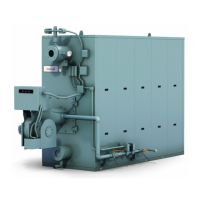
